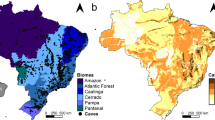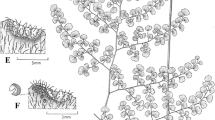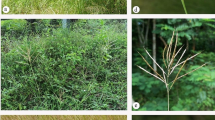Abstract
Data are presented on the occurrence of Braconidae (Hymenoptera parasitica) parasitizing insects associated with forest and ornamental trees and shrubs in Israel. Fifty-five genera of plants are listed, the richest in braconid fauna being tamarisk (9 species); acacia, pistachio and poplar (8 species each); carob and oak (7 species each). Of the 95 species of insect hosts mentioned, 53 are Lepidoptera, mostly Gelechiidae (7 species), Pyralidae (6 species), Noctuidae (5 species), Gracillariidae, Tortricidae, Geometridae, Lymantriidae and Lycaenidae (3 species each); 44 are Coleoptera, mostly Cerambycidae (13 species), Scolytidae (12 species), and Bostrichidae (9 species); three are Diptera. Of the 92 species of braconids listed, of which only 65 have been fully named, 56 develop in Lepidoptera, mostly Noctuidae (15 species), Gelechiidae (11 species) and Pyralidae (9 species); 33 species develop in Coleoptera, mostly Cerambycidae (12 species, Bostrichidae (10 species) and Scolytidae (5 species); and three species develop in Diptera. Thirty-eight species are new to the fauna of Israel; at least three of them are new to science,viz., Gnaptodon, Gildoria andDendrosotinus titubatus Papp.
Similar content being viewed by others
References
Avidov, Z. and Harpaz, I. (1969) Plant Pests of Israel. Israel Universities Press, Jerusalem.
Bar, D., Gerling, D. and Roesler, Y. (1979) Bionomics of the principal natural enemies attackingHeliothis armigera in cotton fields in Israel.Envir. Ent. 8:468–474.
Bodenheimer, F.S. (1930) Die Schaedlingsfauna Palaestinas. Monogr. angew. Ent., Beih.Z. angew. Ent. No. 10.;
Bodenheimer, F.S. (1937) Prodromus Faunae Palaestinae.Mem. Inst. Ent. Egypte, Caire 33.
Bytinski-Salz, H. (1954) Insects associated with desert acacias in Israel.Bull. Res. Coun. Israel 4:284–292.
Bytinski-Salz, H. and Sternlicht, M. (1967) Insects associated with oaks in Israel.Israel J. Ent. 2:107–143.
Eisenstein, I. (1983) [Bibleland Butterflies and Moths.] Am Oved, Tel Aviv, (in Hebrew)
Gerling, D. (1969) The parasites ofSpodoptera littoralis Bois. (Lep., Noctuidae) eggs and larvae in Israel.Israel J. Ent. 4:73–81.
Gerling, D. (1973) The influence of some external factors upon the sex ratio ofBracon hebetor Say (Hymenoptera: Braconidae).Envir. Ent. 2:134–138.
Gerling, D. (1978). [Survey of Natural Enemies of Larvae Noxious to Field Crops.] Progress Report, Dept. of Zoology, Tel-Aviv University, Ramat Aviv, Israel mimeo., 11 pp. (in Hebrew)
Gerling, D. and Kugler, J. (1973) Evaluation of Enemies of Noxious Plants in Israel as Potential Agents for the Biological Control of Weeds. Final Techn. Rep., Project No. A10-Ent-36, to U.S. Dept. Agric, Dept. of Zoology, Tel-Aviv University, Ramat Aviv, Israel.
Gothilf, S. (1969) Natural enemies of the carob moth,Ectomyelois ceratoniae (Zeller).Entomophaga 14:195–202.
Gothilf, S. (1969) A contribution to the biology ofPhanerotoma flavitestacea Fi., a parasite ofEctomyelois ceratoniae (Zell.).Israel J. Ent. 4:55–71.
Halperin, J. (1973) [Lithocolletis millierella, its biology and natural enemies.]Gan vaNof 29:123–128. (in Hebrew)
Halperin, J. (1974) [Biology and natural enemies ofLithocolletis platani.]Gan vaNof 29:195–202. (in Hebrew)
Halperin, J. (1976) [Insect pests of forest and ornamental trees.]in: Encyclopaedia of Agriculture, Tel Aviv. vol. 3, pp. 609–640. (in Hebrew)
Halperin, J. and Holzschuh, C. (1984) Contribution to the knowledge of bark beetles (Coleoptera: Scolytoidea) and associated organisms in Israel.Israel J. Ent. 18:21–37.
Kugler, J. (1966) A list of parasites of Lepidoptera from Israel.Israel J. Ent. 1:75–88.
Mason, W.R.M. (1981) The Polyphyletic Nature ofApanteles Foerster (Hymenoptera: Braconidae): A Phylogeny and Reclassification of Microgastrinae.Mem. ent. Soc. Can. 115.
Mendel, Z. and Halperin, J. (1981) Parasites of bark beetles (Col. Scolytidae) on pine and cypress in Israel.Entomophaga 26:375–379.
Nakache, Y. (1981) [Biological control ofArenipses sabella.]Alon haNote’a 35:527–528.(in Hebrew)
Papp, J. (1970) A contribution to the Braconid fauna of Israel (Hymenoptera).Israel J. Ent. 5:63–75.
Rechav, Y. (1975-78) Biological and ecological studies of the parasitoidChelonus inanitus (L.) (Hymenoptera: Braconidae) in Israel. I. (1975)Entomophaga 20:365–372; II. (1976)J. ent. Soc. sth Afr. 39: 83-85; III. (1978)Entomophaga 23:89-94.
Wysoki, M. and Izhar, Y. (1981) Biological data onApanteles cerialis Nixon (Hymenoptera: Braconidae), a parasite ofBoarmia (Ascotis) selenaria Schiff. (Lepidoptera: Geometridae).Phytoparasitica 9:19–25.
Author information
Authors and Affiliations
Rights and permissions
About this article
Cite this article
Halperin, J. Braconidae (Hymenoptera) associated with forest and ornamental trees and shrubs in Israel. Phytoparasitica 14, 119–135 (1986). https://doi.org/10.1007/BF02980898
Received:
Revised:
Issue Date:
DOI: https://doi.org/10.1007/BF02980898




